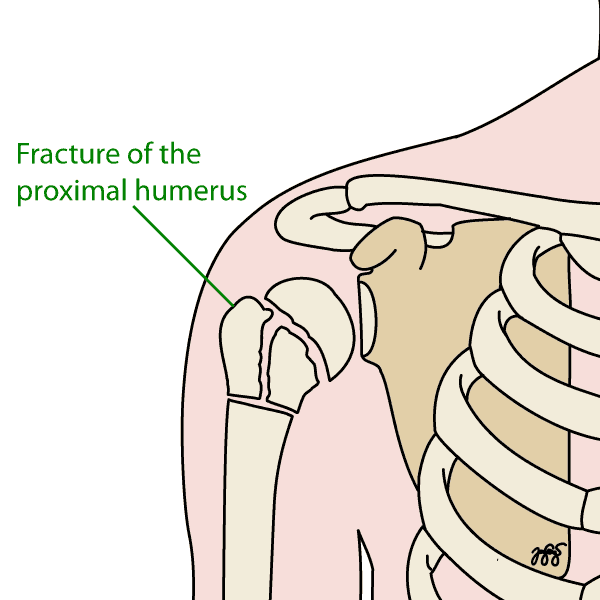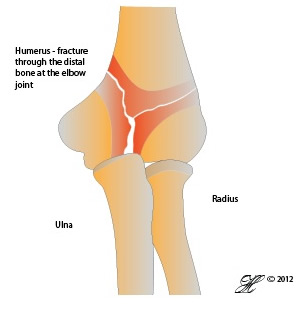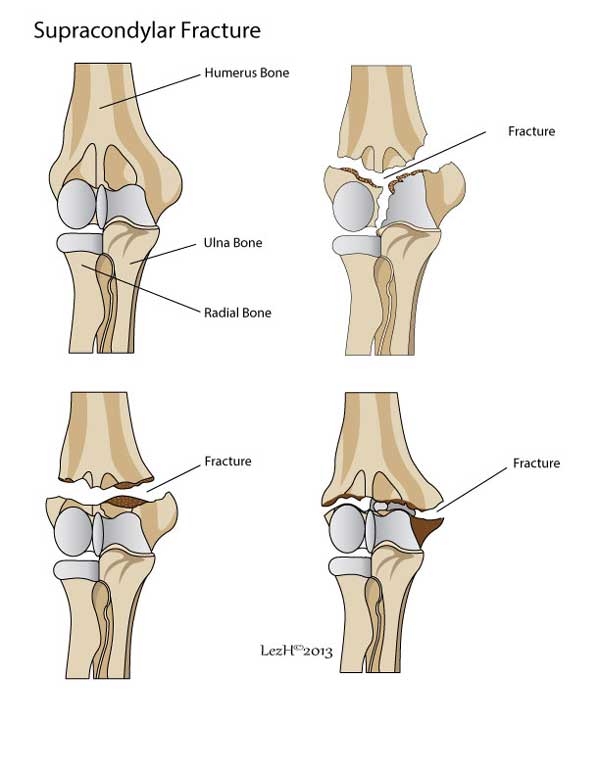The humerus is the bone of your upper arm. It connects your shoulder to your elbow.
The treatment of your humerus fractures depends on many factors. One of those factors is the location of the break.

Surgeons divide the humerus into 3 main areas:
- Proximal humerus. Fractures in the proximal humerus occur near the shoulder joint. These fractures often occur in older patients with osteoporosis and can effect the long term flexibility of the shoulder.
- Mid-shaft humerus. These fractures are located in the middle of the humerus and are often treated by casts, braces and slings. There is a special nerve, called the Radial Nerve, that may by injured or bruised when the middle of the humerus is fractured.
- Distal humerus. These fractures are very common in children and very often need to be straightened / re-aligned into a proper position and temporarily held with surgical pins, wires or screws. In Adults, these fractures often involve the elbow joint, and commonly need an operation to properly fix it. Depending on the exact location, distal humeral fractures can also be called Supracondylar Fractures.

Symptoms
- Pain in the arm
- Swelling
- Bruising
- Reduced ability to move arm
- Tingling or numbness in the hand

Causes
Fractures high up in the bone (proximal humerus) – These are most commonly caused by a fall on an outstretched arm in people with weak bones. Other causes include car accidents or a fall directly onto the shoulder tip.
Fractures in the middle of the bone (midshaft) – These can be caused from a fall on an outstretched arm, car accidents, a fall from a height, or from bone cancer.
Fractures occurring with only minimal trauma may be due to:
- Osteoporosis
- Bone cancer
- Paget disease
- Chronic kidney disease
- Bone cyst
- HIV infection
Risk Factors
Older people are more likely to fracture the humerus due to osteoporosis.
Certain types of humerus fractures, those towards the elbow, are more likely in children.
Investigations
An X-ray gives a good picture of the arm bones, and is usually the only investigation required. It allows doctors to plan treatment based on the location and type of fracture.
A CT scan may be required if initial x-rays don’t show up a fracture but doctors still suspect that one might be present.
A bone density scan may be required if there is a suspicion of weak bones, or osteoporosis.
Complications
Damage to nerves: a nerve supplying the arm, forearm and hand can be damaged by bone spikes. This can result in tingling, numbness, pain or weakness in these areas.
Damage to blood vessels: major arteries bringing blood to the arm are susceptible to damage by bony fragments in the arm.
Malunion: this is when the fracture heals in an abnormal way, such that the normal structure of the bone is disrupted. This may result in the bone not being completely straight.
Nonunion: this is when the two ends of the fracture fail to join together, leaving two separate fragments of bone instead of one united bone.
Shoulder stiffness: this is due to the affected arm being immobilised during the healing process. It can be prevented by certain exercises during recovery.
Treatment
If the broken bone is crooked, it will need to be straightened.
You will be given some medicine first so the straightening is not too painful.
You may be given a splint for your arm for a few days until the swelling begins to go down.
Then your arm will be put in a plaster cast and sling for 4 to 8 weeks.
Your healthcare provider may prescribe anti-inflammatory medicines or other pain medicines.
You should elevate your arm on a pillow or the back of a chair as often as possible for the first 2 to 3 days. This will help control pain and swelling. You may place ice packs over the cast for 20 to 30 minutes every 3 to 4 hours for the first 2 to 3 days.
Take care not to get your cast wet if it is a plaster cast.
Some fractures that cannot be straightened, or that are broken into many pieces, may need to have surgery.
Seeking Advice
Your Family Doctor (GP)
Your Family Doctor will be able to diagnose and help treat your problem. He or she will be able to
- tell you about your problem
- advise you of the best treatment methods
- prescribe you medications
- and if necessary, refer you to Specialists (Consultants) for further treatment
Your Emergency Department
If you have sustained a severe injury to your arm, you should attend your emergency department for assessment.
Prevention
Osteoporosis, if found early by bone density scans, can be treated with a variety of vitamins and medications which improve bone strength. This can reduce the risk of fracture following trauma.
